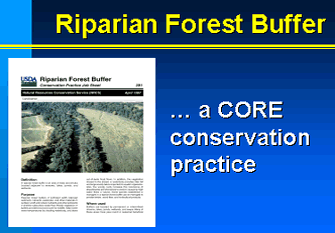Core Principle 4: Conservation Buffers - Riparian Forest Buffer
A riparian forest buffer is an area of trees and shrubs located adjacent to streams, lakes, ponds, and wetlands. Riparian forest buffers of sufficient width intercept sediment, nutrients, pesticides, and other materials in surface runoff and reduce nutrients and other pollutants in shallow subsurface water flow. Woody vegetation in buffers provides food and cover for wildlife, helps keep water temperatures cooler by shading small streams, and slows out-of-bank flood flows. In addition, the vegetation closest to the stream or waterbody provides litter fall and large woody debris important to aquatic organisms. Also, the woody roots increase the resistance of streambanks and shorelines to erosion caused by high water flows or waves.For riparian forest buffers to achieve specific purposes, they must be properly located and sized (width, length, area) in relation to the stream or waterbody. The general widths listed in the figure are based on the average findings from many scientific studies. The right buffer width for a given purpose actually may vary from stream to stream based on stream size and other factors. Because of this variability in buffer width requirements from place to place, a 3-zone minimum buffer is sometimes used as a minimum guideline when planting a buffer where there is little or none.
The 3-zone minimum buffer concept starts with a zone (identified as zone 1) that begins at the normal water line, or at the upper edge of the active channel (or top of the bank), and extends a minimum of distance of 15 feet, measured horizontally on a line perpendicular to the watercourse or waterbody. Bank vegetation along practically all streams plays a crucial role in reducing soil erosion and land loss as well as performing other functions; one or both sides of a stream may need treatment where a vegetated buffer is absent from zone 1. To reduce excess amounts of sediment, organic material, nutrients, and pesticides in surface runoff and to reduce excess nutrients and other chemicals in shallow ground water flow, zone 2 is needed. On small streams, zone 2 will begin at the edge and up-gradient of zone 1 and extend a minimum distance of 20 feet. For larger streams or waterbodies, the minimum combined widths of zones 1 and 2 is 100 feet or 30 percent of the geomorphic floodplain, whichever is less. The minimum length of zones 1 and 2 must match the adjacent dimension of the source field or area. For greatest effect, the buffer length can be extended along the entire waterbody within the ownership, or beyond if possible. Zone 3, regardless of practices used, is an area of sufficient size identified and created to control concentrated flow or mass soil erosion that may degrade zones 1 and 2. A variety of practices may apply such as critical area planting, mulching, use exclusion, and filter strips.
![[logo] US EPA](https://www.epa.gov/epafiles/images/logo_epaseal.gif)
